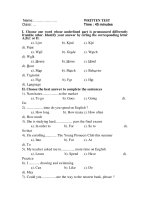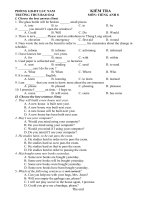- Trang chủ >>
- Đề thi >>
- Đề thi lớp 8
đề kiểm tra tiếng anh lớp 8 theo từng unit (9)
Bạn đang xem bản rút gọn của tài liệu. Xem và tải ngay bản đầy đủ của tài liệu tại đây (68.36 KB, 7 trang )
Giaoandethitienganh.info
Full name: ...............................................
ENGLISH LANGUAGE TEST
Class: ......................................................
Time: 45 minutes
I. LISTENING
1. Listen to the conversation between David and Son about David's trip to Sa Pa.
Decide whether the sentences are true (T) or false (F). Circle T or F. You will listen
TWICE.
1. David likes Sa Pa very much.
T
F
2. Ham Rong Mountain has a charming landscape.
T
F
3. Son hasn’t come to Cat Cat village.
T
F
4. Cat Cat villagers make great handicrafts.
T
F
5. David regretted trekking in the valleys.
T
F
2. Listen to Amy talking about the custom of drinking tea around the world. Match the
country with its information. You will listen TWICE.
1. Morocco
A. Chai is the national drink here.
2. India
B. Matcha is a ceremony here.
3. Japan
C. People here drink coffee in the mornings and tea in the evenings.
4. New Zealand
D. This country have to import tea from others.
5. USA
E. Mint tea is the heart of the culture.
II. READING
1. Read the passage and decide whether the sentences are true (T) or false (F). Circle
T or F.
John, 13
On weekdays I usually hang out with my friends after school. Every
Thursday afternoon, I attend Teens’ Cookery Club. I fancy cooking,
and
I can make lots of delicious cookies. My ambition is to become an
internationally recognized cook.
Thomas, 14
As soon as the school finishes I often go home immediately. My
cousin, who studies in the same school, usually comes over on
Wednesday evening and we play chess with each other. Unlike me,
he is very good at this game. I have learnt a lot from him. I think
playing chess improves my intelligence and critical thinking. It is a
very useful sport.
Mango, 14
I love painting. That’s why I attend the art club at my school every
Tuesday and Friday. We have a teacher, and she often encourages
us to paint our way. We are not charged for joining the club, but we
pay $10 per month to buy necessary stuff. That’s pretty cheap. I
would like to become an artist to inspire people’s creativity.
1. All the above teenagers attend a club after school.
T
F
2. John wants to become a famous cook in the world.
T
F
3. Thomas is very good at playing chess.
T
F
4. Mango has to pay $10 to join her school art club.
T
F
5. Mango's teacher doesn't make her students paint like her.
T
F
2. Read the passage about the practice of ancestor worship in Viet Nam. Match the
activities in A with their status in B. Write your answers in the space provided.
The practice of ancestor worship is relatively straightforward. Nearly every house, office, and business in Viet Nam
In the past, the income from a plot of land was used to maintain the altar and arrange the rituals, but this tradi
Another traditional element is the placing of wooden tablets on the altar for each of the ancestors over recent
A
B
_____ 1. Burn incense sticks and paper gifts.
_____ 2. Use income from a plot of land to maintain the
Page 2 of 7
A. Faded away
altar.
_____ 3. Place wooden tablets on the altar.
B. Still popular today
_____ 4. Eldest son arrange the ceremonials.
C. Seen today, but not popular
_____ 5. Pagodas house commemorative tablets for
ancestors on behalf of regular worshippers.
III. WRITING
1. Write a short paragraph (80-100 words) about one of your leisure activities.
You should use the following cues:
- What it is
- How long you have had it
- What its benefits are
- Something you would like to change about it
_____________________________________________________________________________
__________________________________
_____________________________________________________________________________
__________________________________
_____________________________________________________________________________
__________________________________
_____________________________________________________________________________
__________________________________
_____________________________________________________________________________
__________________________________
_____________________________________________________________________________
__________________________________
_____________________________________________________________________________
__________________________________
2. Complete each of the following sentences using the cues given. You can use other
words in addition to the cues to complete the sentences.
Here is an example.
0. I have to/clean/room.
Answer: 0. I have to clean my room.
1. You/shouldn’t/point/prong/fork/upwards/during/meal.
__________________________________________
2. You/can/use/fork/pick/more/food/dish.
__________________________________________
3. The knife/hold/right/hand/and/fork/hold/left/hand.
__________________________________________
Page 3 of 7
4. When/meal/finish/,/you/should/put/knife and fork/plate.
__________________________________________
5. Same/cutlery/apply/eat/main/course/and/dessert.
__________________________________________
IV. SPEAKING
1. Now I’m going to ask you FOUR questions about your favourite fairy tale. Are you
ready?
1. What is your favorite fairy tale?
2. Who are the main characters in the story?
3. What happened in the story?
4. What lessons did you learn from the story?
2. Each of you will now receive a card. On the card there is a picture and clues for five
questions. You should use the words to make questions and ask your friend. Your
friend will answer the questions based on the picture he/she has.
CARD A
Use the words given below to make questions. Ask your friend about his/her picture and listen
to the answers.
1. What/see/picture?
2. Where/they?
3. What/they/do?
4. What/custom?
5. What/meaning/custom?
Now, your friend will ask you questions about your picture. Answer his/her questions.
CARD B
Page 4 of 7
Use the words given below to make questions. Ask your friend about his/her picture and listen
to the answers.
1. What/see/picture?
2. Where/they?
3. What/they/do?
4. What/custom?
5. What/meaning/custom?
Now, your friend will ask you questions about your picture. Answer his/her questions.
-- The end --
manual page break
Đáp án
I. LISTENING
1. Listen to the conversation between David and Son about David's trip to Sa Pa.
Decide whether the sentences are true (T) or false (F). Circle T or F. You will listen
TWICE.
1. T 2. T 3. F 4. T 5. F
2. Listen to Amy talking about the custom of drinking tea around the world. Match the
country with its information. You will listen TWICE.
1. E 2. A 3. B 4. D 5. C
II. READING
1. Read the passage and decide whether the sentences are true (T) or false (F). Circle
T or F.
1. F 2. T 3. F 4. F 5. T
Page 5 of 7
2. Read the passage about the practice of ancestor worship in Viet Nam. Match the
activities in A with their status in B. Write your answers in the space provided.
1. B 2. A 3. C 4. B 5. C
III. WRITING
1. Write a short paragraph (80-100 words) about one of your leisure activities.
In my free time I often do volunteer work at Green City Club. We meet twice a week and go to Hoan Kiem
Lake to pick up rubbish and put it in the bins. I joined this club three months ago. I think this leisure
activity is very beneficial. It helps to make the environment cleaner, and raises people’s awareness about
environmental pollution. It makes my city more attractive to tourists. I also have the opportunity to use
English to talk with foreigners when doing my work. In the future, I would like to become the vice head of
this club so I can contribute more.
2. Complete each of the following sentences using the cues given. You can use other
words in addition to the cues to complete the sentences.
1. You shouldn’t point the prongs of the folks upward during the meal. 2. You can use the folk to pick more
food from the dish. 3. The knife is held in the right hand and the fork is held in the left hand. 4. When the
meal is finished, you should put the knife and the fork on the plate. 5. The same cutlery is applied when
eating the main course and dessert.
IV. SPEAKING
Page 6 of 7









